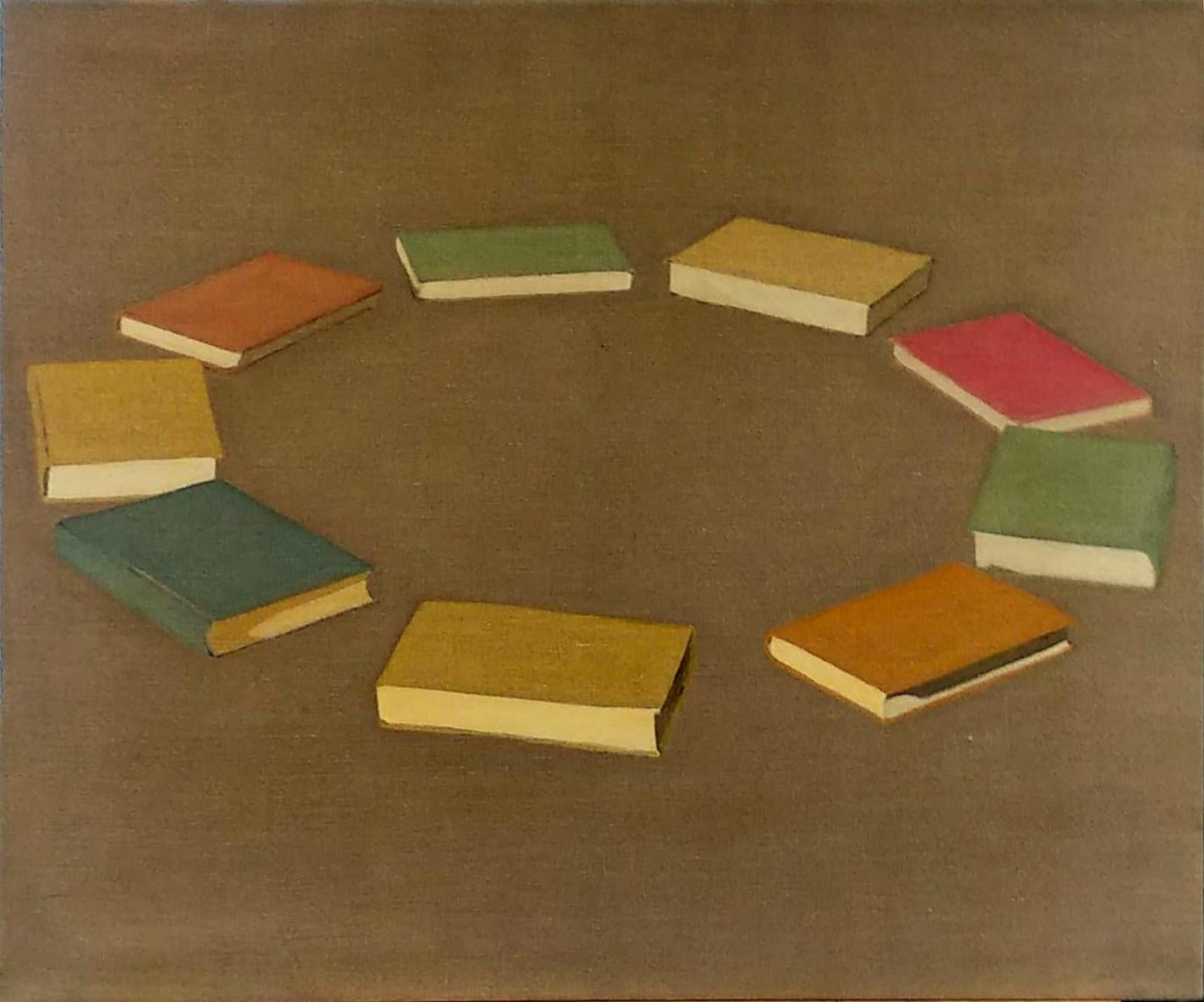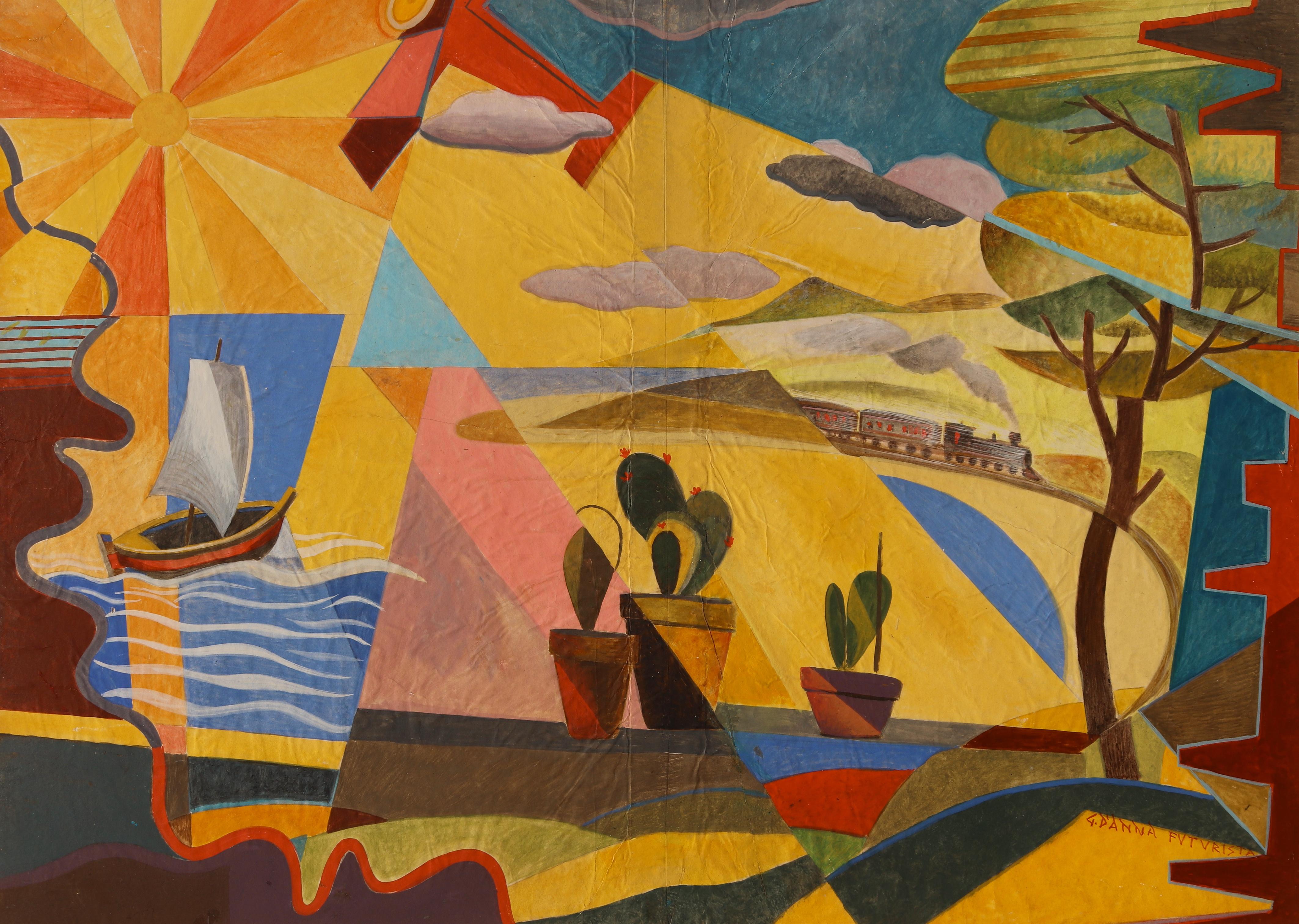Items Similar to Forms Sound Forme rumore, Futurism, Abstract Art
Want more images or videos?
Request additional images or videos from the seller
1 of 5
Giacomo BallaForms Sound Forme rumore, Futurism, Abstract Art1925
1925
About the Item
GIACOMO BALLA 1871-1958
Torino 1871 - 1958 Rome (Italian)
Title: Forms Sound Forme rumore, 1925/30
Technique: Signed Tempera on Card
Size: 19 x 22.7 cm. / 7.5 x 8.9 in.
Additional Information: This tempera is hand signed by the artist "BALLA" at the lower left corner.
It is also stamped “Il Pugno di Boccioni", verso.
It was painted in 1925/30.
Provenance:
Casa Balla, Rome
Galleria Marescalchi, Bologna
Private collection, Treviso
The work is accompanied by a certificate of authenticity issued by Luce Balla.
It is also accompanied by a certificate of authenticity issued by Mrs Elena Gigli of the Archivio Gigli, Rome n.2014/799. TBC
Condition: Very good condition. Soft creasing in the lower right corner.
- Creator:Giacomo Balla (1871-1958, Italian)
- Creation Year:1925
- Dimensions:Height: 7.49 in (19 cm)Width: 8.94 in (22.7 cm)
- Medium:
- Period:
- Condition:
- Gallery Location:London, GB
- Reference Number:1stDibs: LU1803839111
About the Seller
4.7
Gold Seller
These expertly vetted sellers are highly rated and consistently exceed customer expectations.
Established in 1981
1stDibs seller since 2013
160 sales on 1stDibs
Typical response time: 9 hours
- ShippingRetrieving quote...Ships From: London, United Kingdom
- Return PolicyA return for this item may be initiated within 3 days of delivery.
More From This SellerView All
- Composition - American painting, Post War ArtBy Mark TobeyLocated in London, GBMARK TOBEY 1890-1976 Centerville 1890 - 1976 Basel (American) Title: Composition, 1968 Technique: Original Tempera Painting on Paper Paper size: 15.5 x 11.5 cm. / 6.1 x 4.5 in. ...Category
1960s Abstract Paintings
MaterialsTempera
- Je ne sais ou il va?By Junko FrankLocated in London, GBJUNKO FRANK (Junko Tsuchihachi) b. 1930 Wakayama, Japan 1930 (Japanese) Title: Je ne sais ou il va?, 1969 Technique: Original Signed and Dated Oil Painting on Canvas size: ...Category
1960s Abstract Abstract Paintings
MaterialsOil
- Untitled SF80-1191By Sam FrancisLocated in London, GBSAM FRANCIS 1923-1994 San Mateo, California 1923 – 1994 Santa Monica (American) Title: Untitled SF80-1191, 1980 Technique: Stamp Signed Acrylic on tissue thin Japan paper Paper si...Category
1980s Abstract Abstract Paintings
MaterialsAcrylic
- Eclipse - American Kinetic Art - 1961By Alexander CalderLocated in London, GBALEXANDER CALDER 1898-1976 Lawnton, Pennsylvania 1898 - 1976 New York (American) Title: Eclipse, 1961 Technique: Signed and Dated Gouache on Wove Paper Size: 55 x 74.5 cm. / 21.7 ...Category
1960s Kinetic Abstract Paintings
MaterialsGouache
- Yellow Square, Red Square and Blue TriangleBy Marcel JancoLocated in London, GBMARCEL JANCO 1895-1984 Bucarest 1895-1984 Ein Hod (Rumanian/Israeli) Title: Yellow Square, Red Square and Blue Triangle Technique: Original signed Oil ...Category
20th Century Abstract Abstract Paintings
MaterialsCanvas, Oil
- Composition - Japanese Abstract FrenchBy Jun DobashiLocated in London, GBJUN DOBASHI 1910-1975 1910 - Tokyo-1975 (Japanese) Title: Composition, 1962 Technique: Original Signed and Dated Oil Painting on Canvas size: 93 x 75 cm / 36.6 x 29.5 in Additio...Category
1960s Abstract Abstract Paintings
MaterialsOil
You May Also Like
- Hanan Shlonsky, Circle of Literature, 2007 tempera on linen, 82x100 cmLocated in Jerusalem, ILHanan Shlonsky Circle of Literature, 2007 tempera on linen 82x100 cm Exhibited: Comparative Literature, 2009 Artists' House Tel-Aviv , paintings on l...Category
2010s Minimalist Figurative Paintings
MaterialsTempera, Linen
- Margaret Balzer, 1946Located in Washington, DCModern painting by Margaret Balzer Cantieni (1914-2002). Tempera on wood board. Signed in lower right corner "Balzer '46". Painting measures 1 1" x 14" with frame 16 1/2" x 19 1/2". Margaret Balzer studied at the Art Institute of Chicago with Lyonel Feininger, Josef Albers and William Stanley Hayter...Category
1940s Abstract Abstract Paintings
MaterialsBoard, Egg Tempera
- Surface CP/869 SteelBy Guiseppe CapogrossiLocated in Roma, RMSURFACE CP/869 Steel 1951 Tempera, pencil on twelve paper tiles, on sheet Tempera, pencil on twelve layers of paper, on sheet cm 31 x 24 (sheet) 15 x 20 (panel) EXHIBITONS F.R. Mor...Category
1950s Abstract Abstract Paintings
MaterialsPaper, Mixed Media, Tempera
- SimultaneoLocated in London, GBThrough bold colours and striated surfaces, Giulio D'Anna has captured the warmth and vibrancy of the Italian landscape. This collage is an early example of D'Anna's work, a truly cl...Category
Early 20th Century Abstract Paintings
MaterialsTempera, Board
- Ceremonial Dancers oil and tempera painting by Julio De DiegoBy Julio de DiegoLocated in Hudson, NYArtwork measures 48" x 30" and framed 56 ¼" x 38 ¼" x 3" Provenance: John Heller Gallery, NYC, circa 1975 (label verso) The artist's daughter Corbino Galleries, Sarasota, FL (1990)...Category
1940s Modern Abstract Paintings
MaterialsMasonite, Oil, Tempera
- The Magician oil and tempera painting by Julio de DiegoBy Julio de DiegoLocated in Hudson, NYJulio De Diego’s Atomic Series paintings made an extraordinary statement regarding the shock and fear that accompanied the dawn of the nuclear age. In the artist’s own words, “Scientists were working secretly to develop formidable powers taken from the mysterious depths of the earth - with the power to make the earth useless! Then, the EXPLOSION! . . . we entered the Atomic Age, and from there the neo-Atomic war begins. Explosions fell everywhere and man kept on fighting, discovering he could fight without flesh.” To execute these works, De Diego developed a technique of using tempera underpainting before applying layer upon layer of pigmented oil glazes. The result is paintings with surfaces which were described as “bonelike” in quality. The forms seem to float freely, creating a three-dimensional visual effect. In the 1954 book The Modern Renaissance in American Art, author Ralph Pearson summarizes the series as “a fantastic interpretation of a weighty theme. Perhaps it is well to let fantasy and irony appear to lighten the devastating impact. By inverse action, they may in fact increase its weight.” Exhibited 1964 Marion Koogler McNay Art Institute, San Antonio, Texas This work retains its original frame which measures 54" x 42" x 2" About this artist: Julio De Diego crafted a formidable persona within the artistic developments and political struggles of his time. The artist characterized his own work as “lyrical,” explaining, “through the years, the surrealists, the social-conscious painters and the others tried to adopt me, but I went my own way, good, bad or indifferent.” [1] His independence manifested early in life when de Diego left his parent’s home in Madrid, Spain, in adolescence following his father’s attempts to curtail his artistic aspirations. At the age of fifteen he held his first exhibition, set up within a gambling casino. He managed to acquire an apprenticeship in a studio producing scenery for Madrid’s operas, but moved from behind the curtains to the stage, trying his hand at acting and performing as an extra in the Ballet Russes’ Petrouchka with Nijinsky. He spent several years in the Spanish army, including a six-month stretch in the Rif War of 1920 in Northern Africa. His artistic career pushed ahead as he set off for Paris and became familiar with modernism’s forays into abstraction, surrealism, and cubism. The artist arrived in the U.S. in 1924 and settled in Chicago two years later. He established himself with a commission for the decoration of two chapels in St. Gregory’s Church. He also worked in fashion illustration, designed magazine covers and developed a popular laundry bag for the Hotel Sherman. De Diego began exhibiting through the Art Institute of Chicago in 1929, and participated in the annual Chicago Artists Exhibitions, Annual American Exhibitions, and International Water Color Exhibitions. He held a solo exhibition at the Art Institute of Chicago in the summer of 1935. Though the artist’s career was advancing, his family life had deteriorated. In 1932 his first marriage dissolved, and the couple’s young daughter Kiriki was sent to live with friend Paul Hoffman. De Diego continued to develop his artistic vocabulary with a growing interest in Mexican art. He traveled throughout the country acquainting himself with the works of muralists such as Carlos Merida, and also began a collection of small native artifacts...Category
1940s American Modern Abstract Paintings
MaterialsMasonite, Oil, Tempera
Recently Viewed
View AllMore Ways To Browse
Creased Art
Futurism Futurism
Futurism Art
Futurism Painting
Abstract Futurism
Italian Futurism
Futurism Italy
Luce Signed
Di Giacomo
Balla Giacomo
Giacomo Balla Artist
South Orange
Mexican Texas
Black White Yellow Art Abstract
Palm Beach Abstract Paintings
Abstract Modern Art Woman
White Painting Black Lines
Black Brushstrokes





